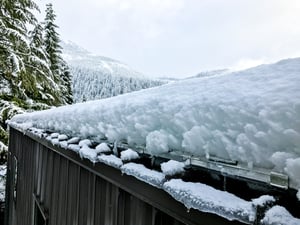Any snow retention system is a life-safety and property protection application. If the system were to fail, tons of snow could suddenly be released onto anything below, threatening personal safety and property. For this reason, any system should be appropriately engineered to the specifics of the project to ensure that it does not structurally fail. Surprisingly, few (if any) vendors who manufacture provide adequate technical data to do this.
This may be due to apathy or inexperience—or perhaps just an unwillingness to spend the money it takes to perform the necessary testing and certifications. In any case, it is neglectful and dangerous.
A Failure in Design Can Cause a Rooftop Avalanche
Each project varies as to the roof size and slope (roof pitch) as well as the jobsite location. The steeper the slope the more force exerted by sliding snow. The greater the eave-to-ridge dimensions of the roof, the more roof surface that collects fallen snow—and the same force is increased. The job location also matters because some localities experience heavier snowfall than others. Heavier snowfall also increases the sliding (vector) force of snow that the system must withstand. When all of these variables are known, the exact force to be resisted can be determined through mathematical computations that enable us to design a system that will not fail.
So how does this system design then take place? We must test the system’s attachment to the metal roof panel seam with sophisticated tensile load testing equipment at an accredited third-party laboratory. The equipment applies and records load (in pounds) in a direction parallel to the roof seam to simulate snow pushing against the system. The load is continually increased until the connection fails. This test is performed at least three times to ensure the failure loads are consistent. Taking the average of these tests, a factor of safety is then applied to determine the connection’s “allowable load”. We now have sufficient test results and a value (in pounds of force) to engineer and populate a system for any specific project given the variables mentioned above.
While this sounds rather simple, there is a hitch: The failure load will vary from one seam profile geometry to the next and one clamp design to the next. It will also vary with the gauge thickness of the metal roof panel material, and even the manufacturer as they may use different grades of steel or aluminum. The seam clamp interfaces with the seam in unique ways that affect its holding strength. Even a slight dimensional change from one manufacturer to the next can alter the tested failure loads significantly. Given so many variables, we must test each manufacturer-specific seam profile in different gauges of material, and often in two or more different material types as well—both steel and aluminum, and in some cases also copper and zinc.
This is why it is important to know the metal roof panel profile, gauge and manufacturer when installing clamp-to-standing seam snow guard systems.
The good news is that at S-5! we have done thousands of such tests on hundreds of seam specimens from every major roof manufacturer. The manufacturer and profile names; materials and gauges on our load test tables catalogue all the results. Those tables feed our web-based snow guard calculators. Thus, an appropriately tested system can be calculated for any project or set of variables in minutes, taking the guesswork out of critical life-safety applications.
Upon request, S-5! will also furnish third party test reports and material certifications proving appropriate clamp and seam-specific testing. Beyond that, for a nominal fee, we will provide Registered Professional Engineer stamping of these calculations for any project.
...to our blog to get updates on new content sent straight to your inbox!

